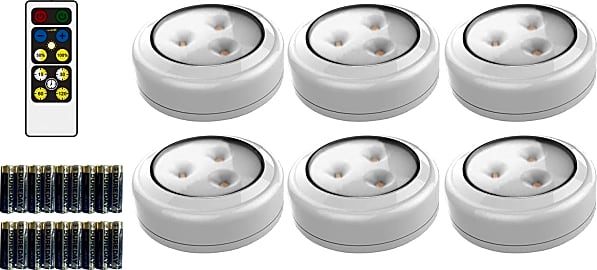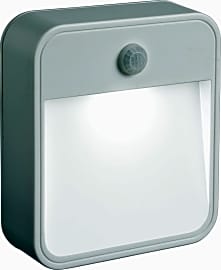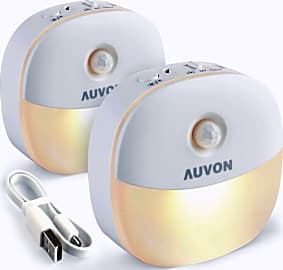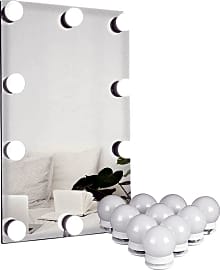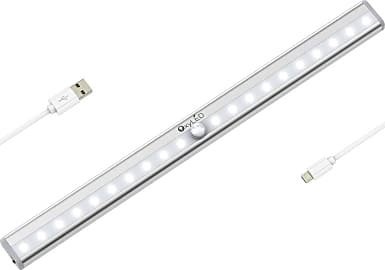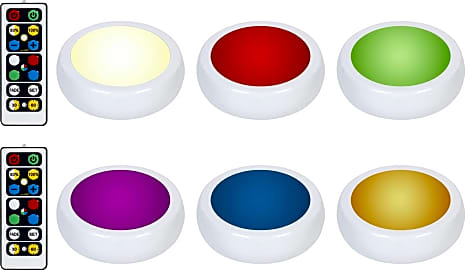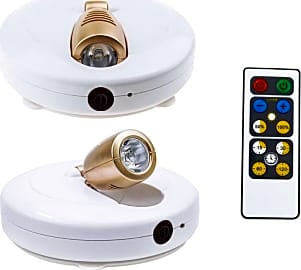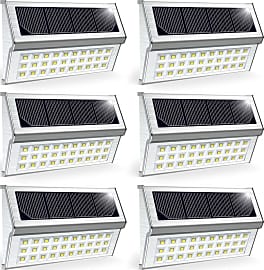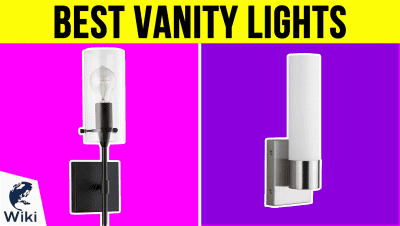The 10 Best Stick-on Lights

This wiki has been updated 39 times since it was first published in October of 2015. If you need just a little extra illumination under cabinets, in closets, on stairs, or even in your car, but don't want the hassle of hardwiring, try one of these easy-to-install stick-on lights. They come in a variety of styles to match any decor and taste. With options for indoors and outdoors, and a range of prices to meet any budget, there's something here for everyone. When users buy our independently chosen editorial choices, we may earn commissions to help fund the Wiki.
Editor's Notes
November 04, 2020:
You can find many contenders for the title of best stick-on light, but when it comes to illumination you can count on, models from Mr. Beams and Brilliant Evolution tend to come to the forefront. In fact, we've kept the Mr. Beams MB722 and the Brilliant Evolution Wireless as top choices. The MB722's illumination seems a bit harsh to some, but it's conveniently offered in an amber version that offers a softer glow. The Brilliant Evolution model is supremely simple and quite affordable for a pack of six, so you could use them throughout your home without draining your wallet.
For something a little different, we added the Brilliant Evolution Color Changing, which does exactly what the name indicates. A fun choice for jazzing up closets or shelves, these are easy enough to operate but not terribly bright, so count on them for creating a mood rather than lighting up a whole room. This model takes the place of the Techbee Tap, which aren't necessarily bad, but can't live up to the stiff competition.
We also removed the Mr. Beams Mini. Even though we appreciate the size, changing the batteries can be very frustrating. Instead, we like the Star-Spangled Mini. This light is also quite small, but is brighter. And while the battery compartment isn't as hard to open, note that most options on the smaller side can be a little finicky to work with.
Finally, a note about batteries. While we've selected a couple of USB-rechargeable choices, including the Lofter Rechargeable and the Auvon Night Light, many popular choices still run on AAA or AA batteries. Because such models have a tendency to drain their batteries relatively quickly, you're better off grabbing an architect or desk lamp for long hours of reading or working, which should save you some money over time.
December 22, 2019:
Unfortunately, at this time, we've had to remove the Kuled 3-Pack over concerns about battery corrosion, as well as the Signstek 10, which has occasional issues wherein the motion sensor operates unreliably. There remain plenty of great choices, however, including the popular Mr. Beams MB722 and Mr. Beams Mini. The latter is a smaller version of the former, and is perfect for those areas where you only need a modest amount of illumination. The size and design of the battery compartment can make changing out the batteries a little frustrating, though. For those who need a little more power, we've added the Lofter Rechargeable, a bright but slim option that is great for everything from closets to garages. And it doesn't need constant battery changes like some, such as the Techbee Tap, which tends to run through batteries quite quickly. Finally, we selected the Waneway Mirror Kit, a vanity light choice that will bring a little Hollywood glamour into your home. The adhesive it comes with isn't the strongest, however, so don't be surprised if you need to provide some of your own.
Special Honors
Helios Touch If you just want a cheap, adhesive light to throw on the wall, the Helios Touch are not what you seek. If, however, you need an option that is stylish and eye-catching, and don't mind the price tag, these nifty hexagons might be just right. They come in packs of various sizes, and are touch sensitive for ease of use that's hard to beat. heliostouch.com
No Stick-On Lights? You’ve Been Missing Out
Most people spend a lot of time cooking, eating, and hosting in the kitchen, so why not start there?
If you’re of a certain age, you may remember The Clapper craze during the late 1990s. Among other uses, the device allowed you to turn your lights on and off with a simple clap of your hands. Its main problem was that other noises — such as a cough, a loud television, or a knock on the door — could trigger it, too. Where The Clapper failed in being a little too ambitious, the stick-on light succeeds in its simplicity.
Compared to lights you have to plug into an outlet, set up yourself, or hire a professional to install, stick-on lights are as low-maintenance as it gets. With corded lights, you’re forced to consider both the location of your wall outlets and the appearance of any cords that would run between the light and the outlet. With do-it-yourself projects, you always have to worry about a long, complicated installation process. And once you bring in the pros, you know your wallet is going to take a hit.
So, stick-on lights are simple and affordable. Who cares? Well, we haven’t gotten to their finest trait yet: versatility. They’re typically battery-powered, compact, and lightweight, which enables you to install them in just about any room or space that requires illumination.
Most people spend a lot of time cooking, eating, and hosting in the kitchen, so why not start there? Not only do they make exceptional under cabinet lights, you can set them up inside of your cupboards, as well. This way, when you’re stumbling around the kitchen in the middle of the night looking for a snack, you won’t end up accidentally eating the dog treats again.
They also work great above a bedside table, as a nightlight, or in a hallway that suffers from poor lighting or no lighting at all. If you live in a rental apartment, you know all too well how common it is for attached decks or patios to lack adequate lighting; a stick-on light solves that problem in seconds.
How To Know Your Stick-On Light Is “The One”
I’m a simple guy; my stick-on light doesn’t need to woo me with extravagant features and excessive brightness. A basic, puck-style light that’s easy to tap on and tap off will get the job done just fine. However, I do realize that plenty of folks are a bit more particular; if you happen to fall into that category, you won’t be disappointed with the selection out there.
Motion sensing technology, adjustable beam angles, auto-dimming features, swiveling heads — it’s hard to believe that battery-powered stick-on lights can contain all these capabilities and more, but it’s true. Some even come with extra adhesive pads, which allow you to move the light around your house as you see fit.
To some, the coverage and brightness of the light will play an important role in the decision-making process.
To some, the coverage and brightness of the light will play an important role in the decision-making process. While puck and button models focus the light on a condensed area, light bars and tape lights tend to be greater in length, feature more bulbs, and spread the light out more. Most stick-on lights are designed with LED bulbs, which are more energy efficient and last longer than their fluorescent and xenon counterparts. On the flip side, LED lights typically aren’t quite as warm and bright, so keep that in mind if you long for that vivid, sunny glow.
Many stick-on lights run on conventional AA or AAA batteries, while some of the more high-tech models are rechargeable via a USB cable, which is quite convenient. Not only do these rechargeable lights help you save money on batteries over the long run, you can simply plug them in while you’re gone during the daylight hours, ensuring they’ll be fully charged upon your return in the evening.
If you’re in search of outdoor lighting, you can add an additional energy source to the mix: solar power. Stick-on lights of this variety are often automated to switch on at dusk and turn off around sunrise, using the sun’s rays to power back up during the day.
Since these are permanently located outdoors, select one with a durable, weatherproof design that will prevent it from quickly wearing down in the elements. You should also make sure its adhesive component is compatible with the type of surface — think brick, wood, metal, siding, or glass — to which it will be attached.
Milestones In Lighting Technology
Like many of today’s technologies, human beings have been enjoying electric light for only a tiny fraction of their existence. We’ve been using oil lamps and candles for thousands of years, but it wasn’t until William Murdoch invented gas lighting at the end of the 18th century that the modern era of lighting began.
Like many of today’s technologies, human beings have been enjoying electric light for only a tiny fraction of their existence.
Everyone knows about Thomas Edison and the light bulb, which is recognized as the crown jewel of achievements in lighting, but few people probably realize that more than 20 inventors created incandescent lamps and bulbs prior to Edison’s. Way back in 1809, a man named Humphry Davy publicly demonstrated the first electric lamp.
Plenty of other inventors followed suit, introducing lamps, bulbs, and other lighting devices during the subsequent decades. Following years of research, Edison produced the first 16-watt light bulb in 1880, which lasted an unprecedented 1,500 hours. Historians see this bulb as superior to those that preceded it, thanks to a more robust incandescent material and a high resistance that made it economically feasible to distribute power from a concentrated source.
Since then, innovations over the years have produced additional new styles; a few notable ones include the fluorescent lamp in the early 1900s; a fluorescent light bulb that lasts 60,000 hours in 1991; and finally, the highly popular LED light in 1995.


